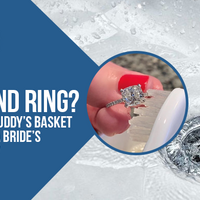Tired of dealing with a slow-draining or clogged bathroom and kitchen sink? Don’t reach for the phone to call a plumber just yet. Many common sink clogs can be cleared quickly and easily using supplies you likely already have at home. With some simple tools and techniques, you can learn how to unclog your sink drain in no time.
This handy guide walks through several DIY methods for clearing sink clogs caused by the usual suspects, like hair, grease and product buildup. We'll cover tried-and-true drain-clearing solutions ranging from plunging to applying baking soda and vinegar. You'll also learn preventative tips to stop clogs before they start.
How to Unclog Your Sink Drain
Sink drains can become clogged in various ways depending on usage and location. Bathroom sinks undergo frequent use, allowing hair, toothpaste and soap scum buildup over time. Kitchen sinks accumulate food particles, grease and other debris that can build up over time.
Unclogging a stubborn clog can be frustrating, but it is often fixable with some simple tools and techniques. Let's walk through five methods to unclog a kitchen or bathroom sink drain, ranging from simple plunging to chemical cleaners.
Method 1: Use a Plunger
Plunging uses suction and pressure to dislodge clogs. It's an effective first step before trying other methods. Plunging is safe for all types of pipes and plumbing fixtures.
To plunge a sink:
- Fill the sink halfway with hot water to allow the plunger to form a seal on the drain.
- If plunging a kitchen sink, seal off the dishwasher drain line using a rubber stopper or clamp. This prevents the clog from being pushed into the dishwasher line.
- Submerge the plunger head entirely under the water. Position it tightly over the drain opening to form an airtight seal.
- Work the plunger up and down rapidly 10 – 15 times. Keep the plunger fully submerged.
- Lift the plunger to break the seal. Check if the water begins draining.
- If the sink still doesn't drain, repeat steps 1 – 5, plunging more vigorously.
- Flush with hot water after plunging to wash away any loosened debris.
Tips:
- Use a plunger with a wide rim for bathroom sinks or a flanged force-cup plunger for kitchen sinks.
- If plunging multiple times doesn't work, the clog is likely too deep, and you'll need to try another method.
- Always keep separate plungers for bathroom and kitchen use to prevent cross-contamination.
Method 2: Boiling Water
Boiling water can be an effective method to clear metal pipe clogs caused by grease buildup. However, avoid using this method on sinks with PVC piping, as the high temperature can damage the pipes.
To use boiling water:
- Bring a pot of water to a rolling boil on the stove. You'll need enough water to pour 4 – 6 cups down the drain.
- Remove the sink stopper and use a cup or small bucket to bail out any standing water.
- Working carefully, pour the boiling water down the drain in a steady stream. Wait a few seconds between pouring each cupful.
- Allow the water to sit for 15 – 30 minutes to give the hot water time to dissolve the clog.
- Run hot tap water down the drain to help flush away any loosened debris.
- If the sink still does not drain, repeat steps 1 – 4 using another pot of boiling water.
Tips:
- Go slowly and carefully when pouring boiling water to avoid splashing.
- Allow the pipes to cool entirely before repeating the process if needed.
- Do not use boiling water on sinks with porcelain finishes, as it can crack the porcelain.
- This method is safe for removing sink clogs in metal pipes only.
Method 3: Baking Soda and Vinegar
Baking soda and vinegar is a natural way to help unclog sinks. The chemical reaction created by mixing baking soda and vinegar breaks up light debris and grease buildup. However, this method may not be strong enough to clear an entirely blocked drain pipe.
To use baking soda and vinegar:
- Remove the sink stopper and scoop out any standing water in the sink.
- Pour one cup of baking soda down the drain. You can use a funnel to direct it down the drain pipe.
- Pour one cup of white vinegar down the drain. The vinegar will react with the baking soda, bubbling and fizzing.
- Place the sink stopper or a towel over the drain to help contain the chemical reaction in the pipe.
- Allow the mixture to sit for 15 – 20 minutes to work on breaking up the clog.
- Remove the stopper from the drain. Run boiling water down the pipe to help flush away debris.
- If needed, repeat steps 1 – 6 until the clog is cleared.
Tips:
- Don’t mix the baking soda and vinegar before you’re ready. The reaction starts immediately.
- Wear gloves when handling baking soda and vinegar to avoid skin irritation.
- Avoid using this method after trying chemical drain cleaners, as it can create dangerous chemical reactions.
Method 4: Drain Snake
A drain snake, or plumber snake, is useful for removing difficult clogs deep in the drain pipe. It is a long, bendable metal cable reaching deep into pipes to snag debris and break up blockages. Drain snakes are more effective on severe clogs than chemicals or boiling water.
To use a drain snake:
- Remove the P-trap under the sink to access the drain pipe. Place a bucket beneath to catch any water.
- Feed the drain snake cable into the pipe opening by hand, then crank the handle to extend it further into the pipe.
- Once you feel resistance, you've found the clog. Turn the crank firmly to force the cable through the clog and dislodge it.
- Once the cable moves freely, retract it from the pipe. Run water to flush debris.
- Clean off the drain snake. Rinse the sink and replace the P-trap.
Tips:
- Wear gloves to protect your hands from grime and the snake.
- Go slowly to avoid scratching the pipe when inserting the snake.
- If you don't own a drain snake, they can be rented or purchased at hardware stores.
Method 5: Chemical Drain Cleaner
Chemical drain cleaners are caustic solutions that dissolve hair, grease and other organic clogs. They contain harsh chemicals like lye or sulfuric acid that can corrode pipes and release toxic fumes, so they should only be used as a last resort if other methods fail.
To use chemical drain cleaners:
- Ventilate the area to avoid breathing in toxic fumes. Some cleaners require wearing gloves and eye protection.
- Remove any standing water from the sink using a cup, bucket or wet/dry vacuum.
- Remove the sink stopper. Chemical cleaners need direct contact with the clog.
- Check the product instructions and pour the recommended amount down the drain.
- Allow the cleaner to work for 15 – 20 minutes. Do not mix chemical cleaners.
- Flush the drain with hot water for 5 minutes to rinse away the corrosive chemicals.
Tips:
- Look for "safer" drain cleaner products that are less toxic and corrosive.
- Never use a chemical cleaner in a completely blocked pipe, as pressure buildup can damage pipes.
- Never use a chemical drain cleaner after trying other methods like baking soda and vinegar, as dangerous chemical reactions could occur.
- Use very sparingly and as a last resort to avoid damaging pipes with repeated use.
How to Prevent Sink Drain Clogs
Preventing clogged drains in the first place is easier and cheaper than clearing them after the fact. Simple preventative measures can save you the hassle and expense of unclogging a sink drain later. By being proactive, you can avoid facing backed-up drains. Follow the tips in this section to stop sink clogs before they occur.
Manage Hair Carefully
Hair is one of the most common causes of clogged bathroom sinks. Follow these tips to keep it from winding up in the drain:
- Clean hair from sinks and shower drains after each use. Wipe strands from the sink and throw them in the garbage rather than rinsing them down the drain.
- Install a hair catcher over bathroom sink drains to trap loose strands before they go down the pipe.
- Avoid washing your hair in the sink if possible.
Perform Preventative Maintenance
Regular maintenance keeps drains free of buildup:
- Pour a pot of boiling water down the drain weekly to dissolve grease and soap scum.
- Use a bent wire hanger or zip-it tool to fish out hair and debris from bathroom drains monthly.
- Treat drains to baking soda and vinegar monthly to break up accumulation and keep pipes fresh.
Avoid Putting Items Down the Drain
Being mindful of what goes down your drains is key to preventing clogs. Don’t treat your drains like a trash can or overload your garbage disposal.
- Avoid putting bones, coffee grounds or fibrous veggies down the sink.
- Don't put more than one cup of food waste at a time in your disposal. Avoid inorganic matter.
- Collect grease, oil and coffee grounds in disposable containers rather than pouring them down the drain. Compost nitrogen and carbon-rich food scraps and coffee grounds if possible.
Use a Drain Strainer or Stopper
Installing a drain strainer or stopper that catches debris prevents clogs before they start. Options like the Drain Buddy act as a stopper and a strainer in one convenient product. The strainer basket catches hair, food particles and other debris, preventing it from building up in the pipes.
Keep Your Sink Drains Clear with Drain Buddy
Using the right DIY drain clearing method for your clog along with some preventative maintenance can help keep your fixtures free of blockages. Investing a little time upfront beats calling an expensive plumber down the road.
An ounce of prevention is worth a pound of cure when it comes to sink clogs. Stop drain blockages before they start with Drain Buddy. Our 2-in-1 drain stopper and hair catcher fits seamlessly into your existing sink to prevent future clogs. Its filter basket traps debris while blending into your bathroom décor with an elegant design.
The Drain Buddy saves you time, money and frustration down the road. Find the perfect Drain Buddy Ultra-Flo collection for your sink or tub to keep your drains flowing freely.






